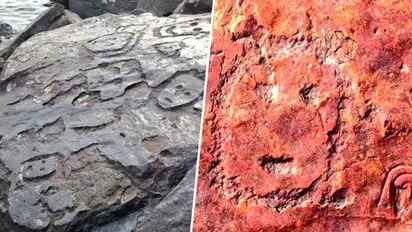'Look like emojis': Amazon river drought reveals 2,000-year-old human faces carved in stone (WATCH)

Synopsis
Historic drought along the Amazon River reveals prehistoric stone carvings, including human faces, shedding light on the region's ancient history.
A historic drought in the Brazilian region has caused the Amazon River's water levels to reach record lows, uncovering ancient stone carvings along the shores of the Rio Negro. These remarkable rock carvings depict various figures, including human faces, animals, and natural forms, shedding light on the area's prehistoric history. The archaeological site, known as Ponto das Lajes or "Place of Slabs," has become a significant find for researchers estimating the carvings to be around 1,000 to 2,000 years old.
Archaeologist Jaime de Santana Oliveira explained that the engravings are prehistoric or precolonial in origin, though precise dating remains challenging. The estimates are based on evidence of human occupation in the region, suggesting their age. While some rock carvings had been spotted previously, this drought has revealed a more extensive variety of carvings, enhancing researchers' ability to trace their origins.
"The engravings are prehistoric, or precolonial. We cannot date them exactly, but based on evidence of human occupation of the area, we believe they are about 1,000 to 2,000 years old," archaeologist Jaime de Santana Oliveira said in an interview.
"Some rock carvings had been sighted before, but now there is a greater variety that will help researchers establish their origins," he added.
One section of the site showcases smooth grooves in the rock, believed to have been used for sharpening arrows and spears by Indigenous inhabitants long before European presence in the area. Oliveira noted that while some carvings were first observed in 2010, this year's drought has been more severe, causing the Rio Negro's water level to drop significantly and unveil extensive rock formations and sandy areas previously underwater. Among the discoveries is a sculpture of a human face intricately carved into the rock, adding to the significance of this archaeological site.
The National Historic and Artistic Heritage Institute (IPHAN), responsible for preserving historic sites, has been closely involved in the documentation and protection of these newfound stone carvings. This remarkable find offers valuable insights into the ancient history of the region, further connecting us to its precolonial inhabitants and their artistic expressions.
Check the Breaking News Today and Latest News from across India and around the world. Stay updated with the latest World News and global developments from politics to economy and current affairs. Get in-depth coverage of China News, Europe News, Pakistan News, and South Asia News, along with top headlines from the UK and US. Follow expert analysis, international trends, and breaking updates from around the globe. Download the Asianet News Official App from the Android Play Store and iPhone App Store for accurate and timely news updates anytime, anywhere.